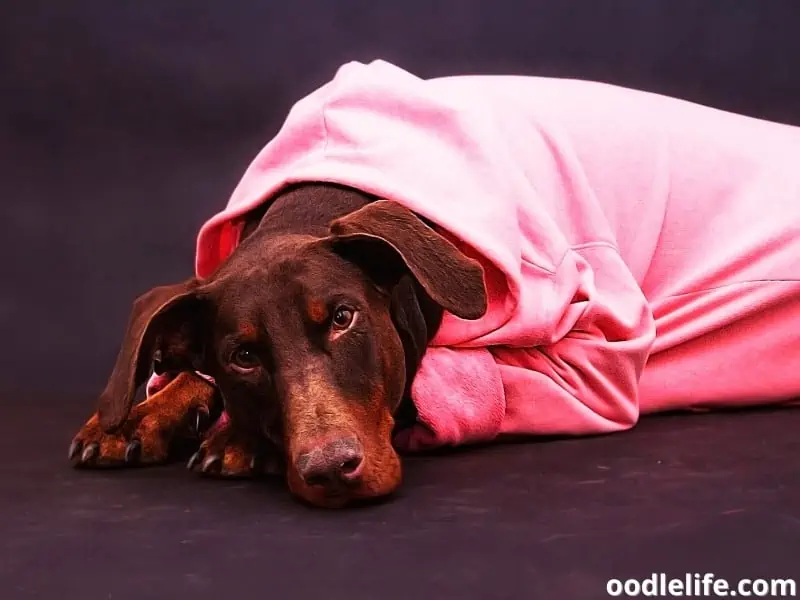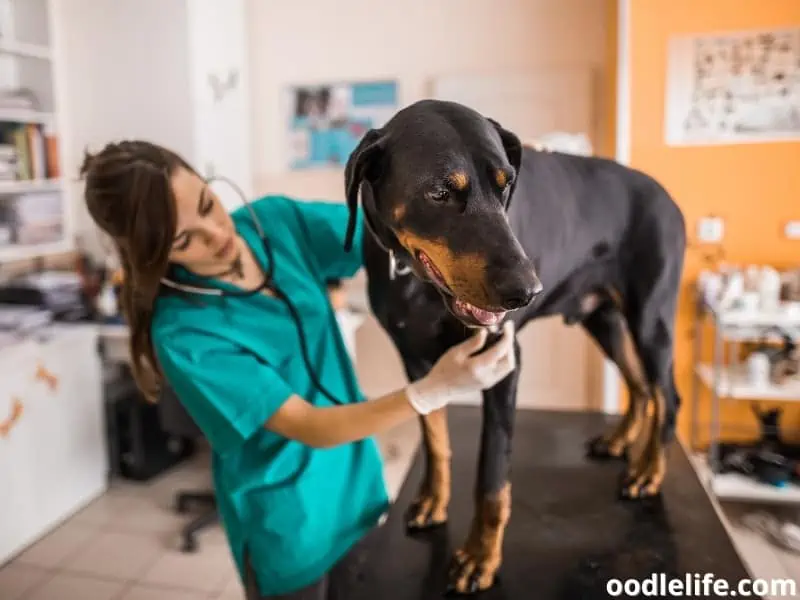Do Dobermans Shed? (How Much?)
When faced with the choice of a new friend, Dobermans are one of the most loyal and protective breeds you could hope for. But how much do Dobermans shed? How much upkeep will you need to be responsible for to keep your pal feeling his best?
We’ll cover everything you need to know about the shedding process for Dobermans, so you know exactly what to expect and how to manage it.

Dobermans and Shedding

Now that we’ve covered the basics of the breed, let’s dive into the details regarding the Doberman’s coat and shedding habits.
Doberman’s Coat Color and Texture
Dobermans are lucky in the summer – they have a short coat, with just a hint of a thicker undercoat around their neck. Their coat color can range from black, red, blue, and fawn (light brown). In rare cases, white is definitely possible if your Doberman is albinistic!
Unfortunately, white Dobermans can have vision problems like photosensitivity, leading to anxious biting. They are also more prone to health problems in general, so just be aware that if you adopt an albinistic Doberman, they’ll require more research and upkeep to keep them healthy and happy.
The Doberman’s coat texture is often smooth and silky. Black Dobermans have the thickest coats and require the most grooming, while light browned Dobermans have the thinnest coats.
However, you can’t predict how much a Doberman sheds just by looking at its coat color.
How Much Do Dobermans Shed?
With the exception of their neck, which has an undercoat, Dobermans have a one-layer coat over their entire body. While many breeds will have variable shedding throughout the year so they can adapt to different seasons, Dobermans shed the same amount all year round.
Overall, Dobermans tend to shed a moderate amount. They are also short-haired, so you won’t find long, thick hair all over the floor.

Signs of Too Much Shedding
So, how much shedding is too much? Look for signs of bald spots, hair accumulating on the floor, and if you have an air filter, check the filter to see if more hair has been collected beyond the norm.
Also look out for unusual behaviors from your Doberman like hiding, excessive licking, aggression, not eating or drinking as much, or being reluctant to go potty. I think all owners know when their dog isn’t feeling good, listen to your gut feeling and take them to the veterinarian if you think something is off.
What Causes Excessive Shedding?
Excessive shedding can have a plethora of causes that you may have never considered. Diet can be a huge factor. If your Doberman isn’t getting the vitamins and minerals they need, shedding can be the first sign that they need to switch foods.
Medical problems like hypothyroidism, which Doberman are predisposed to, can cause excessive hair loss and weight gain.
Allergic reactions to plants and insects will sometimes cause hair loss around the area that touched the irritant. Using anything new in your cleaning routine could be causing hair loss as well.
Grief, moving to a new home, or not being able to see you as much can cause your Doberman to get anxious, and they can start to shed more as a sign of distress.

How To Combat Excessive Shedding?
If you’re unable to determine the cause yourself, contact your veterinarian so they can run bloodwork to ensure that your Doberman isn’t suffering from an underlying health issue.
If your Doberman has lost one of their furry friends, see if you can get them a dog doll with a heartbeat built in. While these are normally used for puppies so they can settle into a new home, there isn’t a rule that says adult dogs can’t benefit from them too!
Consider leaving your dog at a doggy daycare if you are out of town frequently instead of having a pet sitter come by to visit. This should help to alleviate some of their stress over you being gone.
If you’re not familiar with the plants on a new hiking trail, be careful about letting your Doberman run free in them. And if you have introduced a new food, think about switching them back to their old food until you double check the ingredients list with your veterinarian.
You may also want to consider updating your grooming routine so that it’s more gentle, or less frequent.

Grooming Tips
Dobermans have dry skin and tend to not have a strong odor, so frequent bathing isn’t necessary. Unless they roll around in the mud, once every couple of months is fine.
A grooming mitt is a good investment to help remove hair that would otherwise fall to the ground. It also redistributes oils throughout their coat, which keeps it healthy and flexible.
Follow up with a regular brush, and clean the brush thoroughly after each grooming session.
Aim to brush your Doberman at least once a week, and be sure to do it outdoors so you can keep your home clean.
Bathing can be a challenge if your Doberman hasn’t been trained to sit still. Be sure to bring their favorite treats the first couple of times so you can train them to sit and stay. For some dogs, water immediately means play time, especially if you’ve brought out the garden hose.
Try to keep your environment clean and quiet so grooming and bathing can be associated with relaxation instead of a time for the zoomies.
The Doberman tend to be averse to getting dirty in the first place, so you shouldn’t need to bathe them very often. Use cool, but not cold, water, and use your fingers to gently spread shampoo through their hair.
After rinsing the shampoo, you can follow up with a conditioner. This is a good idea if you’ve been washing your Doberman more often, as they can be prone to dry skin.

About Dobermans
What are Dobermans like? What should you consider? Take a peek!
Temperament
Doberman Pinschers are known for being incredible, loyal guardians and are a top choice for police officers. They are practically energizer bunnies but with an impressive physique that demands respect from potential threats.

I’ve come across many fun-loving, cooperative Dobermans – don’t be deterred by their supposed aggressive tendencies. With plenty of exposure to other people and animals, exercise, and proper training, your Doberman can be a gentle, loving member of your family and community.
Dobermans are natural defenders, and if you are looking for protection, they should be your first pick! They don’t require any guidance in this domain, and guard dog classes can actually trigger aggressive behavior.
Outside of Dobermans being incredible protectors, they also make excellent service dogs. If you have issues with mobility, a Doberman can step in and help thanks to their affinity for exercise.
They are also a top-dog for assisting with search and rescue efforts. Firefighters have had Dobermans rescue people from tight, inaccessible locations with their brute strength alone.
All in all, Dobermans have an interesting personality, and they can fulfill a variety of roles beyond keeping people safe from would-be attackers! Like all dogs, they only need a little training to help them in the right direction.
Origin of Breed
Historically, the Doberman came about in the late 1800s thanks to Louis Dobermann. As a professional tax collector, Louis felt he needed a defensive dog when he went door to door collecting unpaid taxes.
While we aren’t sure exactly which breeds Louis mixed, some top picks include the Great Dane, German Pinscher, and Rottweiler. These seem the most likely candidates considering the Doberman’s long, compact head and powerful body.
General Health
Given that Dobermans are a large breed, one of their most common health struggles is bloat. Bloat occurs when the stomach’s blood supply is blocked, usually after the rapid consumption of food and water, which results in the stomach twisting.
They are also vulnerable to developing several genetic health problems, like hypothyroidism and hip dysplasia. To reduce the risk of these health conditions, breeders participate in genetic screening.
Exercise Recommendations
Dobermans require over two hours of exercise a day, or they can get snappy with people and animals. If you don’t feel you can offer that, you can always look into hiring a professional dog walker, sending them to doggy daycare, or having a second dog in your backyard to help them burn some energy off.
You can also pick up a variety of toys for intellectual stimulation. Have your Doberman play fetch and encourage them to run back as vigorously as possible. You’ll know if they have had enough if they’re ready to go take a nap.
Dobermans can sleep over twelve hours a day, so be sure to have a bed ready when they get home!
Final Thoughts
The Doberman is a beautiful [and badass] breed with a sharp appearance, a quick intellect, and a warm heart for their family. They are fiercely protective of those they love and respond well to training and direction. They need a lot of exercise to be their best selves, but they are calm and gentle after they let their energy out.
Their coat can take a little work to maintain, but given that they are short-haired, you at least won’t be dealing with mountains of hair being shed! Remember to follow up with a veterinarian if you notice bald patches or excessive shedding. It’s not always just from over grooming or stress.
If you don’t already own a Doberman, and you’re not sure if you’re ready to take care of one, it can be helpful to go play with them in person. Look for rescues in your area and see if you can come by and visit with the dogs for a few hours. The rescue will likely be grateful that you are putting in the time to learn more and can help you decide if this breed is right for you.